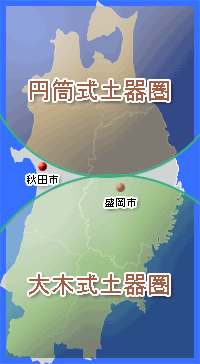In the early Jomon period (about 5000 years ago), the climate was the warmest period, and the vegetation was considered to be a cold-temperate deciduous broad-leaved forest from northern northeast to northern, and a warm temperate deciduous broad-leaved forest in southern northeast. Two earthenware areas have been developed in response to this forestry minister: the Daiki Shiki area and the cylindrical earthenware area. These two earthenware areas were divided in half by the line connecting the current Akita City and Morioka City, and continued until the middle Jomon period (about 4,000 years ago) to Nakaba.
In Ogi-style earthenware culture centered around Sendai Bay in Miyagi Prefecture, flat-bottomed shallow pots, deep pots, and cylindrical earthenware were created with commonality to the grammars such as shrunken sentence and bamboo tube sentence.
On the other hand, the cylindrical earthenware culture that appeared mainly in Aomori Prefecture is called the lower half cylinder type in the first half and the upper cylinder middle type in the middle, and the shape is a simple cylindrical deep pot potter as its name suggests. It was extended to
Hachimantai City's Elder Mansion is one of the prefecture's foremost ruins where 350 residence traces were found during the Jomon period. It occupies the majority. Furthermore, it becomes the large tree type again in the end leaf, and the fusion type with the cylinder lower layer type is established. In this way, it is thought that Ogi-style and Cylindrical-style developed while being influenced by each other.
Two Jomon culture
Updated Date: 2019-03-15

